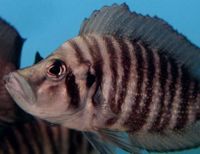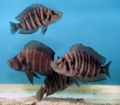Compressed Cichlid (Altolamprologus compressiceps)
From The Aquarium Wiki
(Redirected from Compressed Cichlid)
Compressed Cichlid
Altolamprologus compressiceps
208 Litres (55 US G.)
7.6-15.2cm (3-6 ")
Freshwater
7.8 - 8.6
23.9-27.2°C (75 -81 °F)
12-20 °d
1:1-3 M:F
3-5 years
Family
Cichlidae
This animal is available captive bred
Contents
Additional names
- Compressed Cichlid, Comps
Additional scientific names
- Haplochromis compressiceps, Lamprologus compressiceps, Neolamprologus compressiceps
Origin[edit]
- Endemic to Lake Tanganyika, in Africa.
Sexing[edit]
- Difficult, but mature males tend to be considerably larger than females when mature and have a higher forehead.
Breeding[edit]
- Substrate spawner that forms either pairs or harems. Can be bred in captivity with the right water conditions and environment, breeding in either caves or shells depending on the variant and on what is available in the tank. The cave should be too small for the male to enter, as he may cannibalize the eggs/fry if given the chance. The female lays the eggs in the cave and guards them until they hatch, while the male guards the territory surrounding the cave. The female does not usually leave the cave while caring for the brood, so an easy way to get fry out of this fish is to get a PVC pipe with one closed end, have the fish spawn in it, and transfer the mother and fry to another aquarium. After 10 to 14 days, the fry will be free swimming and capable of taking bbs, and the mother should be removed to prevent her from predating her own fry.
Tank compatibility[edit]
- Docile cichlids that do well in most Tanganyikan communities, as even adult shell dwellers will not be eaten. Their largely passive nature, combined with their sharp scales they use to defend themselves against other cichlids, means that they can also be kept in many other rift lake setups, although very aggressive fish should be avoided. However, they are extremely skilled fry predators and fry are unlikely to survive if they are born into a tank with Altolamprologus in it, and their diet means that fish such as tropheus and mbuna are poor tank mates.
Diet[edit]
- Prefers a meaty diet, including live food, small fish, mysis shrimp, large aquatic insects and crustaceans. Dry foods should be accepted when the fish settle into their tank, especially in captive fish.
Feeding regime[edit]
- Feed once or twice a day, as with most fish.
Environment specifics[edit]
- Like most other Tanganyikan cichlids, this fish does not deliberately damage plants, so plants can be kept as long as they are potted. Most altolamprologus variants grow to about 6 inches and live in rocky areas, so they should be provided with rock piles in a 55 gallon minimum aquarium: however, some populations are shell dwellers that reach only 2-3 inches at most, and these can be kept in 20 gallon long tanks with large shells. Both tank types will look more natural with sand. Altolamps, like most Tanganyikan cichlids, do not take excess nitrates very well, so tanks should have two 25% water changes weekly: they also do not like changing water conditions, so the new water should be close in parameters to the old water.
Behaviour[edit]
- Hunts along the substrate and in narrow crevasses, taking any invertebrates and fish fry it can find - their unusual shape is expressly meant to allow them to find food in rocky crevasses too narrow for other cichlids to fit in. They tend to be innocuous both in the wild and in tanks so as to assist in their fry hunting: if they are attacked, they will bend their body towards the offending fish and expose their sharp scales, which can easily shred the lips of attacking cichlids. They can be territorial towards conspecifics, but as long as the tank has enough hiding places this should not be a problem.
Identification[edit]
- Laterally compressed body (hence the name), sloping forehead and turned up snout. There are vertical stripes running down the body of these fish, but otherwise they are extremely variable, with various black, grey, brown, and yellow variants: some are smaller than others and use shells to live in instead of rock crevasses. The similar A. Calvus has no scales on the top of its head and has a more streamlined body, but is cared for in the same way.
Pictures[edit]
Videos[edit]
| "Orange Top Kigoma" colour morph: |
| "Altolamprologus Compressiceps protecting her eggs: |
External links[edit]
- Fishbase (Mirrors:
 )
)

